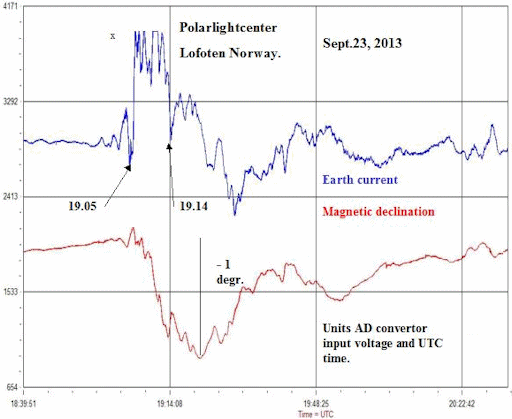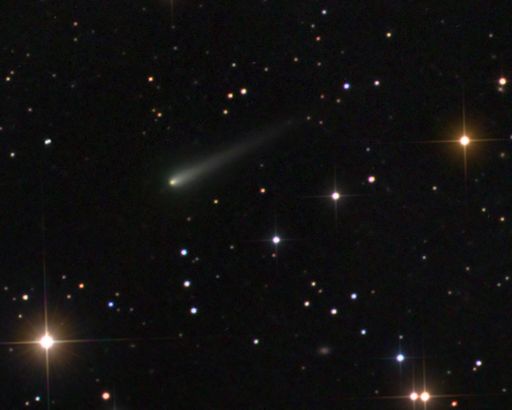They came from outer space--and you can have one! Genuine meteorites are now on sale in the Space Weather Store. | | |
QUIET SUN: Today is another day that seems more like Solar Min than Solar Max. All of the sunspots on the Earthside of the sun are quiet, and solar activity is low. NOAA forecasters estimate a slim 5% chance of M-class flares on Sept. 24th. Solar flare alerts: text, voice.
AURORA SURPRISE: Last night in Norway, compass needles swung 1o away from normal and electric currents began to flow through the ground. For nearly an hour, a local geomagnetic storm occured over the northern part of the country. Rob Stammes recorded the phenomenon from his laboratory at the Polarlightcenter in Lofoten:

"Early on the evening of September 23th, I noticed these strong magnetic and induced earth current variations on my instruments," says Stammes. "At the same time, strong auroras appeared outside our center. The Northern Lights were a nice surprise for our guests."
The display might be related to the approach of a solar wind stream Earth is entering now. Measurements from the ACE spacecraft indicate that the solar wind is quickening, and this is causing magnetic disturbances around the poles on Sept. 24th. Arctic sky watchers should remain alert for auroras. Aurora alerts: text, voice.
Realtime Aurora Photo Gallery
COMET ISON ON TRACK TO BECOME 'IMPRESSIVE': Amateur astronomers around the world are photographing Comet ISON as it approaches Mars in the predawn sky. The comet is not as bright as some forecasters expected. What does that mean for ISON's future prospects? The answer may be found below this color photo of the comet obtained by UK astronomer Damian Peach on Sept. 24th:

Photo details: 17" CDK with FLI-PL6303e camera. LRGB. L: 5x3mins. RGB: 1x2mins. Sun -18 to -14deg.
At the moment, Comet ISON is about as bright as a 14th magnitude star, which puts it one or two magnitudes dimmer than forecasts. Nevertheless, according to several experts speaking in a NASA video, Comet ISON is still on track to become an impressive sungrazer. John Bortle predicts ISON will rival Venus during the hours leading up to its closest approach to the Sun in November, while Matthew Knight notes that Comet ISON is brighter than Comet Lovejoy was at the same distance from the sun in 2011. As many readers remember, Comet Lovejoy went on to become a spectacular naked-eye object. Comet ISON might do the same.
New images of the comet are coming in every day. Browse the gallery for the latest views:
Realtime Comet ISON Photo Gallery
Realtime Space Weather Photo Gallery
Realtime Noctilucent Cloud Photo Gallery
[previous years: 2003, 2004, 2005, 2006, 2007, 2008, 2009, 2011]
Potentially Hazardous Asteroids (
PHAs) are space rocks larger than approximately 100m that can come closer to Earth than 0.05 AU. None of the known PHAs is on a collision course with our planet, although astronomers are finding
new ones all the time.
On September 24, 2013 there were potentially hazardous asteroids.
Recent & Upcoming Earth-asteroid encounters: | Asteroid | Date(UT) | Miss Distance | Size |
| 2000 DK79 | Nov 10 | 49.1 LD | 3.0 km |
| 2011 JY1 | Nov 13 | 8.2 LD | 57 m |
| 2001 AV43 | Nov 18 | 3 LD | 52 m |
| 2010 CL19 | Nov 25 | 37.6 LD | 1.3 km |
| 2013 NJ | Nov 26 | 2.5 LD | 190 m |
Notes: LD means "Lunar Distance." 1 LD = 384,401 km, the distance between Earth and the Moon. 1 LD also equals 0.00256 AU. MAG is the visual magnitude of the asteroid on the date of closest approach. | | The official U.S. government space weather bureau |
| | The first place to look for information about sundogs, pillars, rainbows and related phenomena. |
| | Researchers call it a "Hubble for the sun." SDO is the most advanced solar observatory ever. |
| | 3D views of the sun from NASA's Solar and Terrestrial Relations Observatory |
| | Realtime and archival images of the Sun from SOHO. |
| | from the NOAA Space Environment Center |
| | the underlying science of space weather |

